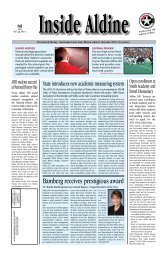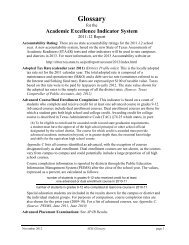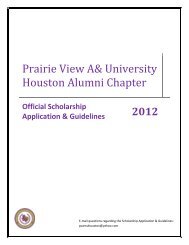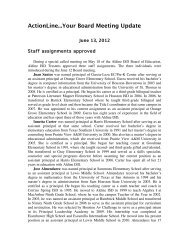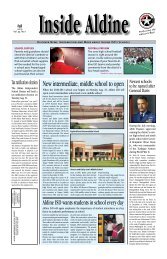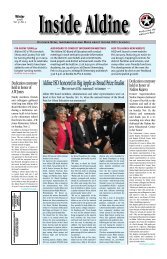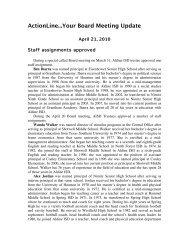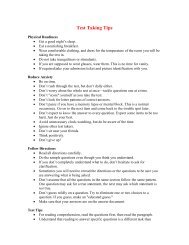Aldine I.S.D. Teacher Handbook - Aldine Independent School District
Aldine I.S.D. Teacher Handbook - Aldine Independent School District
Aldine I.S.D. Teacher Handbook - Aldine Independent School District
Create successful ePaper yourself
Turn your PDF publications into a flip-book with our unique Google optimized e-Paper software.
<strong>Teacher</strong> <strong>Handbook</strong> 2012-2013<br />
educational needs of the students, a lack of student response to particular course<br />
offerings, legislative revisions to programs, and a reorganization or consolidation of<br />
two or more individual schools, administrative areas, or departments.<br />
4. “Discharge” shall mean termination of a contract during the contract period.<br />
5. “Nonrenewal” shall mean the termination of a term contract at the end of the contract<br />
period.<br />
A reduction in force may take place when the Board determines that financial exigency<br />
exists or the Superintendent determines that a reorganization or program change is required.<br />
In either case, this may involve the discharge or nonrenewal of one or more employees.<br />
Such a determination constitutes good cause for discharge or nonrenewal.<br />
When a reduction in force is to be implemented, the Superintendent may assist the Board by<br />
making recommendations to the Board regarding the employment areas to be affected. In<br />
determining affected employment areas, the Board may combine or coordinate employment<br />
areas, as defined below (e.g., the Board may combine elementary programs and<br />
compensatory education programs to identify an employment area of elementary<br />
compensatory education program).<br />
Employment areas include, but are not limited to:<br />
1. Non-Chapter 21 contractual positions;<br />
2. Administrative positions, units, or departments;<br />
3. Educational support programs that do not provide direct instruction to students;<br />
4. Special programs, such as gifted and talented, career and technology education,<br />
bilingual/ESL, special education, compensatory education, migrant education,<br />
magnet, and IB. Each special program is a separate employment area;<br />
5. Counseling programs;<br />
6. Library programs;<br />
7. Nursing and other health services programs;<br />
8. Individual campuses;<br />
9. Elementary grades, levels, subjects, departments, or programs, including Pre-K to<br />
Grade 6; and<br />
10. Secondary grades, levels, subjects, departments, or programs.<br />
Upon the board’s direction, the Superintendent shall apply the criteria to the employees<br />
within the affected employment area(s) and shall recommend for nonrenewal or discharge<br />
those employees who have been identified through such application. The Superintendent<br />
shall apply the criterion sequentially within each employment area to the extent necessary to<br />
identify the employees necessary to nonrenew or discharge in order to accomplish the<br />
necessary reduction in district personnel-related expenditures. If all necessary reductions<br />
can be accomplished by applying the Performance criterion, it is not necessary to apply the<br />
Certification/Licensure criterion and the like. Before any subsequent criterion is used in any<br />
area, the Performance criterion must be exhausted in each affected area. For example,<br />
before a person with an emergency permit may be nonrenewed or discharged based upon<br />
not being fully certified, the Performance criterion must have been applied in every affected<br />
employment area to identify all those persons who would be nonrenewed or discharged<br />
because of performance deficiencies as identified in the Performance criterion.<br />
If the application of the Performance criterion results in an over-identification of persons<br />
for nonrenewal or discharge, then the Certification/Licensure criterion will be used to<br />
reduce the number of identified persons to the number required to accomplish the necessary<br />
reduction. If an over-identification remains, then the Seniority criterion will be used. For<br />
example, if the Certification/Licensure criterion must be applied in order to accomplish the<br />
necessary reduction but also results in an over-identification, then the Seniority criterion<br />
will be applied to those affected staff members so that only those who have less seniority<br />
within the Certification criterion are identified for nonrenewal or discharge.<br />
In order of implementation, the criteria are:<br />
9



